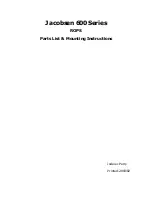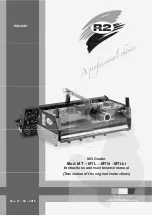
11
Installazione della compostiera
Per prima cosa occorre scegliere un posto dove
installare la compostiera che sia comodo per
spostare il materiale all’interno compostiera e
fuori di essa, di solito in prossimità del giardino.
Scegliere una superficie piana abbastanza spa-
ziosa per ruotare la compostiera e, se possibile,
preferire un posto raggiunto dai raggi solari
diretti in modo da favorire il processo di „cottu-
ra“ del compost.
Per il montaggio occorre solo un cacciavite
Philips. Le istruzioni complete per il montaggio
sono riportate nei fogli acclusi.
Materiali da introdurre nella
compostiera
The composting process works best by mixing
moist greens (nitrogen rich) with dry browns,
(carbon rich) in a ratio of approximately 2 parts
green to 1 parts browns.
Sono materiali verdi: piante da giardino e ap-
partamento, avanzi di cucina, erba tagliata
Sono materiali bruni: rametti, segatura, foglie,
paglia/fieno
Non compostare: carne/grasso/ossi, prodotti
lattiero-caseari, spazzatura/plastica, cenere da
legno, piante infestanti/erbacce
Risoluzione dei problemi
1. Il misto di compost non si riscalda:
• Il misto è troppo umido - aggiungere
materiali bruni secchi
• Il misto è troppo secco - aggiungere
dell‘acqua
• Le proporzioni sono sbagliate - control-
lare il rapporto tra materiali verdi/bruni
e correggere
2. Odore
• Un odore di ammoniaca indica che è
presente troppo azoto (parte verde) -
aggiungere materiali secchi bruni.
• Un odore di marcio (come uova marce)
indica che il misto è eccessivamente
umido e/o non vi è abbastanza ossigeno
- aggiungere materiali secchi bruni per
assorbire l‘umidità eccessiva e ruotare
la compostiera, aprire il foro di ventila-
zione.
3. Problemi con animali domestici/insetti
• I roditori sono attirati da carne e cibi
grassi - eliminare questi rifiuti
• Le mosche/Gli insetti sono attirati da
rifiuti scoperti, specialmente avanzi di
cucina - mischiare o coprire con materi-
ali bruni o con del compost finito.
Riciclaggio dell‘erba: lasciare l‘erba tagliata sul
prato rasato o utilizzarla così com‘è. È un‘otti-
ma fonte di azoto e favorisce l‘assorbimento di
acqua.
Il materiale sminuzzato in piccoli pezzi si
decompone più velocemente. Passare il tagli-
aerba sugli aghi dei pini o sulle foglie e tagliare
a pezzi gli avanzi di cucina per accelerare il
processo di compostaggio.
Trouble shooting
1. Compost mix does not heat up:
• Mix is too wet - add dry brown
• Mix is to dry - add water
• Mix ratio is off - check green/brown ratio
and add accordingly
2. Odor
• Ammonia smell means too much nitrogen
(Green) - add dry brown.
• Putrid smell (Like rotten eggs) means
mix is too wet andqor not enough oxygen
- add dry browns to absorb excessive
moisture and turn composter - open air
vent.
3. Problems with pets/Insects
• Rodents are attracted to meat and fatty
foods - remove them
• Flies/Insects are attracted to uncovered
wastes, esprcialy kitchen scarps - mix or
cover with brown materials or finished
compost.
Grasscycling: Leave grass clippings on
your lawn or use them as much. This is
an excellent source of nitrogen and helps
absorb water
Small shredded materials decompose faster.
Run your lawnmower over pine needles or
leaves and cut up kitchen scarps to speed
the composting process.
Setting-up your composter
First select a location to install your composter
that is convenient to move materials to and from,
usually close to garden. Choose a flat surface with
enough room to be able to rotate the composter
and if able, be sure to select a location in direct
sunlight, to help cook your compost.
To assemble, you will need onle Philips screw
driver. Complete assembly instructions are
included on inserted sheets.
What to put in your composter
The composting process works best by mixing
moist greens (nitrogen rich) with dry browns,
(carbon rich) in a ratio of approximately 2 parts
green to 1 parts browns.
Greens are: Garden and house planters, Kitchen
scraps, Grass clippings
Browns are: Twigs, Saw dust, Leaves, Straw/hay
Do not Compost: Meats/fats/bones, dairy
products, Trush/Plastic, wood ashes, Invasive
plant/weedts
Trouble shooting
1. Compost mix does not heat up:
• Mix is too wet - add dry brown
• Mix is to dry - add water
• Mix ratio is off - check green/brown ratio
and add accordingly
2. Odor
• Ammonia smell means too much nitrogen
(Green) - add dry brown.
• Putrid smell (Like rotten eggs) means
mix is too wet andqor not enough oxygen
- add dry browns to absorb excessive
moisture and turn composter - open air
vent.
3. Problems with pets/Insects
• Rodents are attracted to meat and fatty
foods - remove them
• Flies/Insects are attracted to uncovered
wastes, esprcialy kitchen scarps - mix or
cover with brown materials or finished
compost.
Grasscycling: Leave grass clippings on
your lawn or use them as much. This is
an excellent source of nitrogen and helps
absorb water
Small shredded materials decompose faster.
Run your lawnmower over pine needles or
leaves and cut up kitchen scarps to speed
the composting process.
Setting-up your composter
First select a location to install your composter
that is convenient to move materials to and from,
usually close to garden. Choose a flat surface with
enough room to be able to rotate the composter
and if able, be sure to select a location in direct
sunlight, to help cook your compost.
To assemble, you will need onle Philips screw
driver. Complete assembly instructions are
included on inserted sheets.
What to put in your composter
The composting process works best by mixing
moist greens (nitrogen rich) with dry browns,
(carbon rich) in a ratio of approximately 2 parts
green to 1 parts browns.
Greens are: Garden and house planters, Kitchen
scraps, Grass clippings
Browns are: Twigs, Saw dust, Leaves, Straw/hay
Do not Compost: Meats/fats/bones, dairy
products, Trush/Plastic, wood ashes, Invasive
plant/weedts
IT
Summary of Contents for Compost Roller DUO70
Page 14: ...14 COMPOST ROLLER DUO70 Notizen...


































